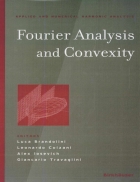




Mã tài liệu: 200788
Số trang: 280
Định dạng: pdf
Dung lượng file:
Chuyên mục: Khoa học công nghệ
In 1901 Hurwitz proved the isoperimetric inequality using Fourier series. It quickly became clear that this approach was not just a curiosity, but rather a fundamental idea with far-reaching consequences and applications in geometry, analysis, and number theory. During the last century the relationship between Fourier analysis and other disciplines has been systematically explored by many researchers resulting in important advances in these areas of study. One hundred years after the seminal paper by Hurwitz, a conference and several short courses dedicated to Fourier analysis, convex geometry, and related topics were held at the Università di Milano-Bicocca. This conference was much more than a collection of long and short lectures: an important aspect of the meeting was the interaction among the speakers and other participants. This interaction bore fruit in the form of joint publications and ever increasing movement towards interdisciplinary connections within mathematics.
An outgrowth of the Milano conference, this volume contains mainly expository or semi-expository invited chapters written by experts in their respective fields. The chapters can arguably be broken up into three categories: number theory, lattice points, and irregularities of distribution, represented by the contributions of Beck, Chen, and Green; interaction between Fourier analysis and convexity, represented by the contributions of (3roemer, Koldobsky, Ryabogin and Zvavitch, Podkorytov, and Travaglini; and interaction among Fourier analysis, geometric measure theory, and combinatorics, represented by the contributions of Berenstein and Rubin, Kolountzakis. Magyar. and Tao. Although the chapters, and lectures on which they are based, were written independently, there is a large number of common themes and connections among them. For example, the Fourier analytic approach to convex geometry is beautifully described in an historical context in Groemer's chapter and echoed and developed by Koldobsky, Ryabogin and Zvavitch, and Berenstein and Rubin. The chapters by Podkorytov and Travaglini reverse the arrow of application by utilizing convex geometric principles to establish Fourier analytic estimates, which in turn are used to prove results in geometric number theory. Common themes abound in the chapters of Beck, Chen, Kolountzakis, Magyar, even though the problems discussed are not apparently of the same nature. We firmly believe that the common themes and connections implicit in the chapters were strengthened and refined by the discussions and interactions that took place during the conference. Furthermore, the connections inherent in these chapters are often deeper and more surprising than one might think. For example, Tao's chapter on restriction theory and Green's chapter on spectral properties of subsets of the integers are not obviously related; nevertheless, it was precisely the interaction between these two fields of study that was an important factor in a number of spectacular breakthroughs by Green and Tao in the study of arithmetic progressions and related problems.
Our hope is that readers will appreciate this book as a testament to the power of interdependence among different areas of mathematics, and not simply as a collection of interesting articles by excellent mathematicians. We believe that the book will be quite useful to graduate students and researchers in harmonic analysis, convex geometry, functional analysis, number theory, computer science, and geometric combinatorial analysis, who wish to learn more about problems where Fourier analysis is used to encode the essence of a mathematical problem in a natural and elegant way. We wish to thank John Benedeuo, editor of the Applied and Numerical Harmonic Analysis book series, for his encouragement and support. We also would like to express our sincere thanks to Tom Grasso of Birkhäuser for his care and patience.
Những tài liệu gần giống với tài liệu bạn đang xem
📎 Số trang: 197
👁 Lượt xem: 602
⬇ Lượt tải: 16
📎 Số trang: 482
👁 Lượt xem: 354
⬇ Lượt tải: 16
📎 Số trang: 538
👁 Lượt xem: 392
⬇ Lượt tải: 16
📎 Số trang: 646
👁 Lượt xem: 312
⬇ Lượt tải: 16
📎 Số trang: 565
👁 Lượt xem: 332
⬇ Lượt tải: 16
Những tài liệu bạn đã xem
 Fourier Analysis and Convexity
Lý thuyết Dow - nền tảng của phân tích kĩ thuật In 1901 Hurwitz proved the isoperimetric inequality using Fourier series. It quickly became clear that this approach was not just a curiosity, but rather a fundamental idea with far-reaching
pdf Đăng bởi
duyhuy08
Fourier Analysis and Convexity
Lý thuyết Dow - nền tảng của phân tích kĩ thuật In 1901 Hurwitz proved the isoperimetric inequality using Fourier series. It quickly became clear that this approach was not just a curiosity, but rather a fundamental idea with far-reaching
pdf Đăng bởi
duyhuy08